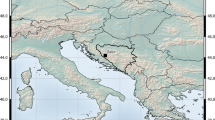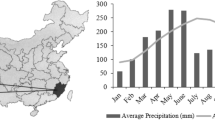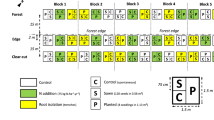Abstract
Influence of tree-to-tree competition on nutrient resorption is still not well understood. To contribute filling this gap, we assessed the effects of thinning (0, 20 and 30 % extraction of basal area) and canopy type (beech–pine vs. pine subplots) on needle dry weight, needle length, nutrient content and nutrient resorption (N, P and K) in Scots pine (Pinus sylvestris) needles of different cohorts, 8–9 years after thinning. Thinning and canopy type often concurrently affected needle morphology (e.g. lighter and shorter needles in 30 % thinning, heavier and longer needles in pine canopy on the first year of study) and nutrient content (e.g. decrease in N, P and K in 30 %; N, P and K higher in pine canopy on the first year of study). However, effects of thinning appeared only in older cohorts for N and P but were found in old and new cohorts for needle dry weight, needle length and K, indicating that some thinning effects remained after 8–9 years. Canopy effects on morphology and nutrient content were more frequent in recent cohorts, in relation to an increase in beech cover over time. While no clear effects of thinning on the nutrient resorption were observed, higher values were observed in the pine than in the mixed canopy, which could be related to a higher Scots pine stem growth in those patches. The observed differences between treatments will likely increase as the stand develops, probably leading to beech trees being dominant, and as future thinnings are carried out.





Similar content being viewed by others
References
Aerts R (1996) Nutrient resorption from senescing leaves of perennials: are there general patterns? J Ecol 84:597–608
Binkley D, Giardina C (1998) Why do tree species affect soils? The warp and woof of tree–soil interactions. Biogeochemistry 42:89–106
Blanco JA, Imbert JB, Castillo FJ (2009) Thinning affects nutrient resorption and nutrient-use efficiency in two Pinus sylvestris stands in the Pyrenees. Ecol Appl 19:682–698
Blanco JA, Imbert JB, Castillo FJ (2011) Thinning affects Pinus sylvestris needle decomposition rates and chemistry differently depending on site conditions. Biogeochemistry 106:397–414
Boerner REJ (1984) Nutrient dynamics and nutrient use efficiency of four deciduous tree species in relation to site fertility. J Appl Ecol 21:1029–1040
Chapin FS (1980) The mineral nutrition of wild plants. Annu Rev Ecol Syst 11:233–260
Chapin FS, Kedrowski RA (1983) Seasonal changes in nitrogen and phosphorus fractions and autumn retranslocation in evergreen and deciduous taiga trees. Ecology 64:376–391
Covelo F, Gallardo A (2002) Effect of pine harvesting on leaf nutrient dynamics in young oak trees at NW Spain. For Ecol Manage 167:161–172
Curt T, Prevosto B (2003) Rooting strategy of naturally regenerated beech in Silver birch and Scots pine woodlands. Plant Soil 255:265–279
Del Arco JM, Escudero A, Garrido MV (1991) Effects of site characteristics on nitrogen retranslocation from senescing leaves. Ecology 72:701–708
Dougherty PM, Whitehead D, Vose JM (1994) Environmental influences on the phenology of pine. Ecol Bull 43:64–75
Fife DN, Nambiar EKS (1997) Changes in the canopy and growth of Pinus radiata in response to nitrogen supply. For Ecol Manage 93:137–152
Gebauer R, Volarík D, Urban J et al (2011) Effect of thinning on anatomical adaptations of Norway spruce needles. Tree Physiol 31:1103–1113
Helmisaari HS (1992) Nutrient retranslocation within the foliage of Pinus sylvestris. Tree Physiol 10:45–58
Hökkä H, Penttilä T, Hanell B (1996) Effect of thinning on the foliar nutrient status of Scots pine stands on drained boreal peatlands. Can J For Res 26:1577–1584
Hothorn T, Bretz F, Westfall P (2008) Simultaneous inference in general parametric models. Biometrical J 50:346–363
Kelty MJ (1992) Comparative productivity of monocultures and mixed-species stands. In: Kelty MJ, Larson BC, Oliver CD (eds) The ecology and silviculture of mixed-species forests. Kluwer, Dordrecht, pp 125–141
Killingbeck KT (1996) Nutrients in senesced leaves: keys to the search for potential resorption and resorption proficiency. Ecology 77:1716–1727
Kobe RK, Lepczyk CA, Iyer M (2005) Resorption efficiency decreases with increasing green leaf nutrients in a global data set. Ecology 86:2780–2792
Mediavilla S, González-Zurdo P, García-Ciudad A, Escudero A (2011) Morphological and chemical leaf composition of mediterranean evergreen tree species according to leaf age. Trees 25:669–677
Millard P, Grelet G-A (2010) Nitrogen storage and remobilization by trees: ecophysiological relevance in a changing world. Tree Physiol 30:1083–1095
Nambiar EKS, Fife DN (1991) Nutrient retranslocation in temperate conifers. Tree Physiol 9:185–207
Niinemets Ü, Tamm Ü (2005) Species differences in timing of leaf fall and foliage chemistry modify nutrient resorption efficiency in deciduous temperate forest stands. Tree Physiol 25:1001–1014
Pinheiro JC, Bates DM (2000) Mixed-effects models in S and S-PLUS. Springer, New York
Pinheiro JC, Bates D, DebRoy S et al (2009) Nlme: linear and nonlinear mixed effects models. R package version 3
Pretzsch H (2005) Diversity and productivity in forests: evidence from long-term experimental plots. In: Scherer-Lorenzen M, Körner C, Schulze ED (eds) Forest diversity and function: temperate and boreal systems. Springer, Berlin, pp 41–64
Primicia I, Camarero JJ, Imbert JB, Castillo FJ (2013) Effects of thinning and canopy type on growth dynamics of Pinus sylvestris: inter-annual variations and intra-annual interactions with microclimate. Eur J For Res 132:121–135
Pugnaire FI, Chapin FS (1993) Controls over nutrient resorption from leaves of evergreen mediterranean species. Ecology 74:124–129
R Development Core Team (2011) R: a language and environment for statistical computing. R foundation for statistical computing. Vienna, Austria
Rothe A, Binkley D (2001) Nutritional interactions in mixed species forests: a synthesis. Can J For Res 31:1855–1870
Sprugel DG, Brooks JR, Hinckley TM (1996) Effects of light on shoot geometry and needle morphology in Abies amabilis. Tree Physiol 16:91–98
Van Heerwaarden LM, Toet S, Aerts R (2003) Current measures of nutrient resorption efficiency lead to a substantial underestimation of real resorption efficiency: facts and solutions. Oikos 101:664–669
Vergutz L, Manzoni S, Porporato A et al (2012) Global resorption efficiencies and concentrations of carbon and nutrients in leaves of terrestrial plants. Ecol Monogr 82:205–220
Von Ende CN (2001) Repeated-measures analysis: growth and other time dependent measures. In: Scheiner SM, Gurevitch I (eds) The design and analysis of ecological experiments, 2nd edn. Oxford University Press, New York, pp 134–157
Zuur AF, Ieno EN, Walker N et al (2009) Mixed effects models and extensions in ecology with R. Springer, New York
Acknowledgments
We thank the “Departamento de Medio Ambiente” of the Government of Navarre, in particular, F. Puertas, for the experimental setting of silvicultural treatments, and the “Concejo” of Aspurz for permitting the access to the plots. We also thank D. Ciganda, J. Markina, X. Petrirena and E. Urmeneta for their help in the field work, and Euken Arriaga, Arkaitz Arretxe, Susana García, Iñigo Iriarte and Ieltxu Oteiza for their help in the laboratory and data processing. The research has been carried out in the framework of the AGL2006-08288 project (Economy and Competitiveness Ministry of the Spanish Government). I. Primicia was financially supported by the FPI programme from the Economy and Competitiveness Ministry of the Spanish Government and the European Social Fund (ESF).
Author information
Authors and Affiliations
Corresponding author
Additional information
Communicated by A. Merino.
Electronic supplementary material
Below is the link to the electronic supplementary material.
Rights and permissions
About this article
Cite this article
Primicia, I., Imbert, J.B., Traver, M.C. et al. Inter-specific competition and management modify the morphology, nutrient content and resorption in Scots pine needles. Eur J Forest Res 133, 141–151 (2014). https://doi.org/10.1007/s10342-013-0753-7
Received:
Accepted:
Published:
Issue Date:
DOI: https://doi.org/10.1007/s10342-013-0753-7




